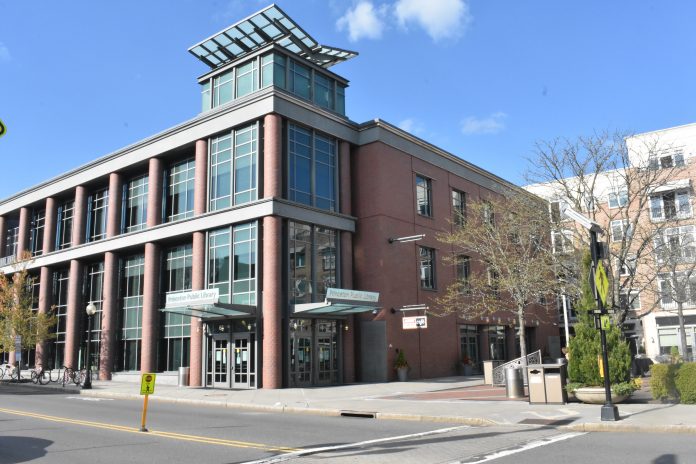
TABLE OF CONTENTS
A one-day photo exhibit and a panel discussion about the Princeton Public Library building – plus the obligatory birthday cake – will highlight a special anniversary of its opening on April 24.
The photo exhibit, titled “It was 20 Years Ago Today,” will display photographs of the first day that the building – the third one in the Princeton Public Library’s 114-year history – opened its doors on April 24, 2004.
The photographs were taken by photographer Cie Stroud, and will be on exhibit in the Community Room from 1-9 p.m.
At 5 p.m., Princeton Public Library staff member Anna Lewis will give a tour of Ik-Joong Kang’s “Happy World.” It is one of the signature pieces of public art in the library building. Princeton community members contributed artifacts to the mural.
The Princeton Public Library staff will blow out the candles on the birthday cake at 6 p.m., followed by a series of short films by Lambertville filmmaker Tom Florek about the history, art and architecture of the library building.
The 7 p.m. panel discussion, which will be streamed on the library’s YouTube channel, will feature former Princeton Public Library executive director Leslie Burger; former Princeton Public Library Board of Trustees chairman Harry Levine; and architect Nicholas Garrison, who designed the building while he was working for Hillier Architecture.
Tim Quinn, the library’s marketing and communications director, will lead the panel discussion. Attendees may share their thoughts after the panel discussion.
Princeton Public Library Executive Director Jennifer Podolsky said many people assumed that the library was always housed in a facility as magnificent as the current building, which is named after benefactors George H. Sands and his wife, Estelle M. Sands – but that’s not true.
The present library building is the third one to house the Princeton Public Library. The library opened its doors in 1910 in the historic Bainbridge House on Nassau Street, next to the Garden Theater. Its collection was about 4,000 volumes, and staffed by one librarian.
The Princeton Public Library was preceded by the Princeton Library Company, the Ivy Hall Book Club and the Witherspoon Street Free Lending Library, according to “A Narrative History of the Princeton Public Library” by William K. Selden.
The Princeton Library Company was organized in April 1812 by a small group of local merchants and tradesmen, according to “A Narrative History of the Princeton Public Library.”
The Princeton Library Company was succeeded by the Ivy Hall Book Club and the Witherspoon Street Free Lending Library. They became the basis for the Princeton Public Library, which opened its doors in the Bainbridge House in 1910.
The Princeton Public Library outgrew the Bainbridge House, and plans were developed for a larger facility. The decision was made to build it on the corner of Witherspoon Street and Wiggins Street.
Architect Thaddeus Longstreth designed the 27,000-square-foot building, which was constructed in 1966. Almost as soon as it opened, the library building was deemed to be too small. Expansion plans were considered, but later dropped.
The decision was made to raze the 1966 library building and construct the present 58,000-square-foot library building at a cost of $18 million.
The former Princeton Borough and former Princeton Township, which jointly operated the library, contributed $6 million toward the costs. The rest of the money was raised through private funds.
Princeton real estate investor George H. Sands and his wife, Estelle M. Sands, for whom the Princeton Public Library building is named, were the largest private donors. They gave $5 million which was to be divided between an endowment and construction costs.
Additional funding for the construction of the library was obtained through grants and a donation from Princeton University.

